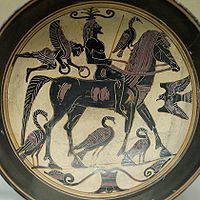
Rider Painter
Encyclopedia

Laconia
Laconia , also known as Lacedaemonia, is one of the regional units of Greece. It is part of the region of Peloponnese. It is situated in the southeastern part of the Peloponnese peninsula. Its administrative capital is Sparti...
n vase painter
Laconian vase painting
Laconian vase painting is a regional style of Greek vase painting, produced in Laconia, the region of Sparta in the 7th century BC.The first pottery with ornamental decoration produced in Laconia belongs to the Geomteric period. It was rather lifeless and appears provinvial in comparison to more...
; he was active between 560 and 530 BC. He is considered one of the five great vase painters of Sparta
Sparta
Sparta or Lacedaemon, was a prominent city-state in ancient Greece, situated on the banks of the River Eurotas in Laconia, in south-eastern Peloponnese. It emerged as a political entity around the 10th century BC, when the invading Dorians subjugated the local, non-Dorian population. From c...
.
His coventional name is based on his name vase
Name vase
In classical archaeology, a name vase is a specific "vase" whose painter's name is unknown but whose workshop style has been identified. The painter is conventionally named after the selected "name vase" that embodies his characteristic style, or for one of its distinctive painted subjects, or for...
at the British Museum
British Museum
The British Museum is a museum of human history and culture in London. Its collections, which number more than seven million objects, are amongst the largest and most comprehensive in the world and originate from all continents, illustrating and documenting the story of human culture from its...
in London
London
London is the capital city of :England and the :United Kingdom, the largest metropolitan area in the United Kingdom, and the largest urban zone in the European Union by most measures. Located on the River Thames, London has been a major settlement for two millennia, its history going back to its...
, with an image of a horseman. He painted various shapes, including lebetes
Lebes
The lebes was originally a type of ancient Greek pot, a deep bowl with a rounded bottom. It needed a stand, frequently a sacrificial tripod, to remain upright. In classical times a foot was attached, and it was typically used as a mixing bowl in food preparation...
, a rare shape in Sparta
Sparta
Sparta or Lacedaemon, was a prominent city-state in ancient Greece, situated on the banks of the River Eurotas in Laconia, in south-eastern Peloponnese. It emerged as a political entity around the 10th century BC, when the invading Dorians subjugated the local, non-Dorian population. From c...
, but predominantly kylikes
Kylix (drinking cup)
A kylix is a type of wine-drinking glass with a broad relatively shallow body raised on a stem from a foot and usually with two horizontal handles disposed symmetrically...
. He primarily produced for export, as indicated by the fact that one one of his works has so far been discovered in Laconia. His workshop cannot be located, but was perhaps in a perioikic
Perioikoi
The perioeci, or perioikoi, were the members of an autonomous group of free but non-citizen inhabitants of Sparta. Concentrated in the beach and highland areas of Laconia, the name περίοικοι derives from περί / peri, "around," and / oikos, "dwelling, house." They were the only people allowed to...
settlement. Since identifiable painting styles and peculiarities in vase shapes tend to be consistent, it is assumed that the Rider Painter, like other Laconian vase painters, was both potter and painter. He is considered somewhat inferior in talent to the other four great Laconian vase painters. He mainly depicted scenes from Greek mythology
Greek mythology
Greek mythology is the body of myths and legends belonging to the ancient Greeks, concerning their gods and heroes, the nature of the world, and the origins and significance of their own cult and ritual practices. They were a part of religion in ancient Greece...
, such as the blinding of Polyphemus
Polyphemus
Polyphemus is the gigantic one-eyed son of Poseidon and Thoosa in Greek mythology, one of the Cyclopes. His name means "much spoken of" or "famous". Polyphemus plays a pivotal role in Homer's Odyssey.-In Homer's Odyssey:...
, Kadmos or Herakles. Other motifs include scenes from everyday life, such komasts
Komos
The Komos was a ritualistic drunken procession performed by revelers in ancient Greece, whose participants were known as komasts. Its precise nature has been difficult to reconstruct from the diverse literary sources and evidence derived from vase painting....
or the eponymous rider.

